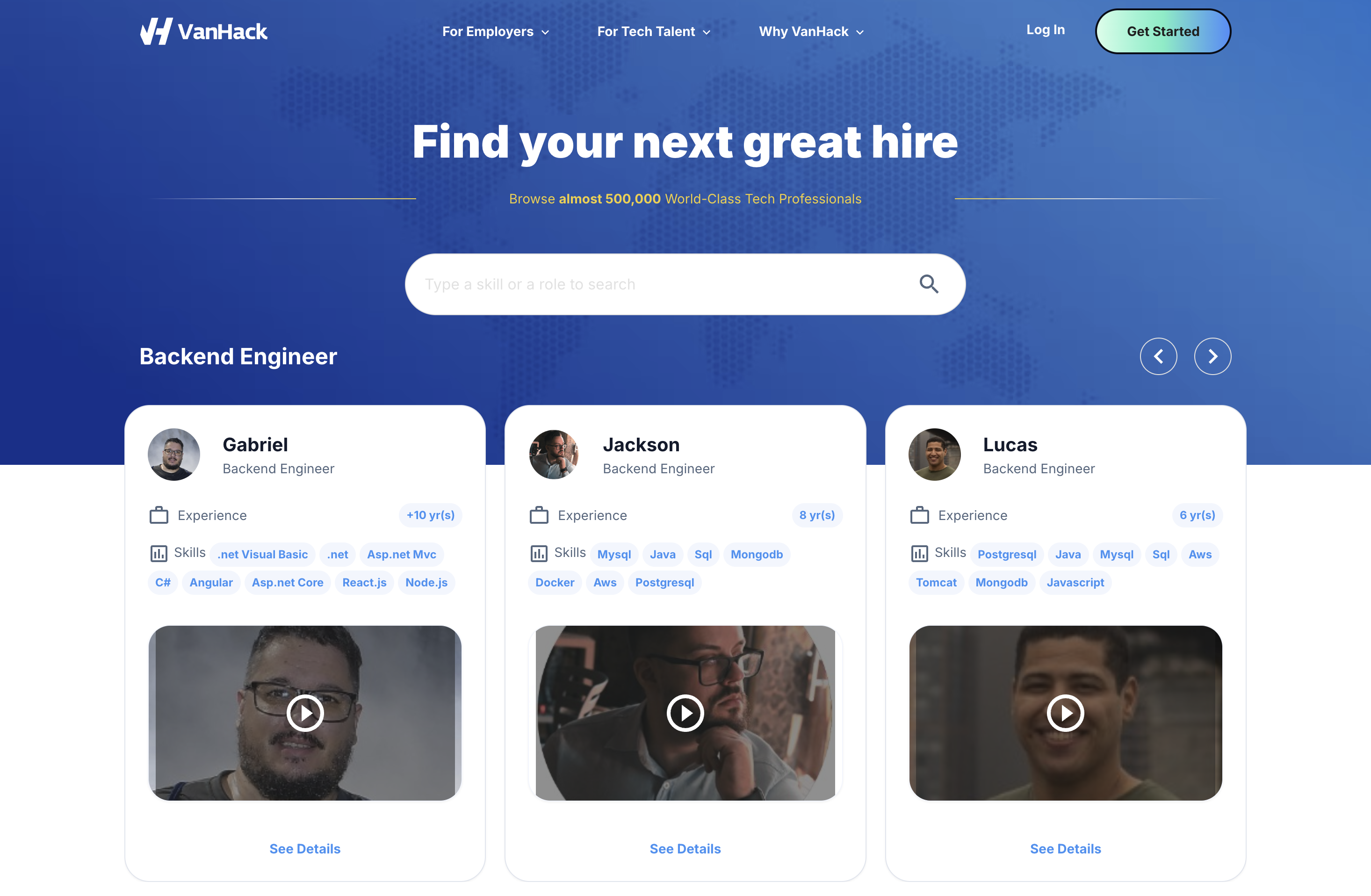Finding skilled engineering talent is a top priority for US tech companies in today’s competitive market. With domestic talent shortages and the rising complexity of US work visas, especially sponsor programs, many leaders are rethinking how they hire. This guide offers a clear look at hiring remote LATAM developers, breaking down visa options, exploring practical alternatives, and showing how global talent can give your company an edge. Adapting to a worldwide talent pool can help you stay ahead of competitors stuck in old hiring patterns. Start hiring with VanHack to connect with top talent quickly.
Key Insights for Hiring LATAM Tech Talent
Hiring the right talent is more than just filling roles. It directly affects how fast you develop products, how well your team performs, and how you stand in the market. For senior engineering roles with 5 to 10+ years of experience, costs go beyond salaries. You also need to factor in equity packages and immigration expenses.
Modern hiring focuses on thorough technical evaluations, not just basic coding tests. It also considers cultural fit for remote teams and addresses startup challenges like offering competitive pay and building a strong employer brand. Your talent strategy should match your product timelines and business goals.
When deciding whether to build an in-house hiring system or partner with experts, consider your company’s maturity, available resources, and timeline. Larger firms with HR and immigration experience might handle it internally. Startups often benefit from partnerships that provide instant access to global networks and proven hiring methods.
Current Trends in Tech Talent Hiring
The tech talent market has changed a lot, driven by remote work, AI tools for candidate assessment, and rising salary expectations. Today, Big Tech, startups, and specialized platforms all compete globally, where skills and team fit matter more than location.
Hiring solutions now include focused tech recruiting platforms and AI matching tools, moving beyond old-school agencies. Successful companies stand out by engaging tech communities, strengthening their brand, and offering creative pay structures.
Traditional hiring methods like job boards or referrals often fall short for startups. They lack the deep technical vetting and global reach needed for senior roles. New approaches, such as accessing worldwide talent and improving candidate experiences, are becoming the standard for staying competitive.
Challenges with US Sponsor Visas for LATAM Developers
H-1B Visa Costs and Limits for Remote LATAM Talent
The H-1B visa, once a key way to bring international tech talent to the US, now poses major hurdles. It requires a bachelor’s degree or equivalent experience, where three years of work counts as one year of college. Many LATAM developers qualify, but the process is far from easy.
Only 65,000 regular H-1B visas are available each year, plus 20,000 for those with US master’s degrees or higher. A lottery system decides who gets them, making it hard to plan. On top of that, a new $100,000 filing fee for first-time applicants starts after September 21, 2025, changing the cost equation dramatically.
This fee spike means six-figure expenses per applicant, not counting legal costs or delays. Such high costs are pushing companies toward remote and nearshore hiring options instead of direct sponsorship.
Visa Delays and Uncertainty in Sponsorship
High costs aren’t the only issue. Processing delays create major roadblocks for sponsoring LATAM developers. Employment-based visa categories, including EB-3 for skilled workers, face significant backlogs.
In key LATAM markets, the situation is worse. US consulates in Mexico and Colombia have stopped scheduling new interviews since May 2025 due to limited resources, causing indefinite waits.
These delays disrupt hiring plans. Unpredictable timelines make it tough to align talent needs with product goals or funding rounds. With high costs, low odds, and uncertain schedules, sponsoring LATAM talent through traditional visas is less practical than ever.
Practical Alternatives to US Sponsor Visas
Remote and Nearshore Hiring as a Solution
Rising H-1B fees and complications are driving companies to remote and nearshore models, skipping immigration challenges altogether. The $100,000 H-1B fee makes sponsorship less appealing, pushing firms to hire LATAM talent via contract or employer-of-record setups.
This approach goes beyond saving money. Hiring remotely avoids US immigration rules, allowing quick team growth and reduced risk. You can build distributed teams without worrying about legal hurdles or government delays.
Other benefits include faster access to talent. Remote hiring lets you tap into skilled developers in weeks, not years. This speed helps maintain project momentum and seize market opportunities without visa-related slowdowns.
Specialized providers handle vetting, cultural fit, and onboarding, easing the load on your HR and legal teams. This lets you focus on business goals while connecting with high-quality talent efficiently.
Other US Visa Options and Their Limits
While other visa types exist, they fit narrow cases rather than broad hiring needs. The O-1 visa, for those with extraordinary skills, demands proof of major achievements like patents or awards, which most developers don’t have. The L-1 visa, for intracompany transfers, requires a prior relationship between foreign and US entities, limiting its use.
These options don’t offer a steady way to hire LATAM talent at scale. Their strict rules and complex processes mirror H-1B challenges. For most companies, remote models provide a better path to global talent without the costs or delays of immigration. Recruit faster with VanHack to access pre-vetted LATAM developers hassle-free.
Why Choose VanHack for Global Tech Hiring?
Connect with Pre-Vetted LATAM Talent for Remote Work
VanHack simplifies hiring LATAM developers by offering a platform tailored for remote roles. We connect North American companies with experienced, pre-screened tech talent from Latin America, helping you hire efficiently without visa complications.

Our “All You Can Hire” subscription, called “Vanna,” uses AI to assist with recruiting and allows unlimited hires for a flat $3,000 monthly fee. This saves money compared to per-hire agency costs, making budgeting easier for growing companies.
For each role, we provide a shortlist of 3 to 5 pre-vetted candidates. This cuts down on screening time, letting you focus on senior talent with 5 to 10 years of experience in areas like Full-Stack or Backend development.
Complete Relocation Support for Canada and Europe
If relocation is needed, VanHack offers full Global Mobility services for moves to Canada and Europe. Unlike others who only place candidates, we manage the entire process, from visa applications to finding housing and schools, all within the same pricing.
This support reduces your administrative workload, ensuring a smooth move for candidates and their families. We even set up local WhatsApp groups to help new hires connect with peers in their new city.
Thorough Vetting for Quality and Speed
VanHack’s vetting process gives you clear insights into candidates before interviews. Profiles include video intros to check English and communication skills, 30-minute recorded AI technical interviews, and coding test scores with benchmarks.
These tools help hiring managers quickly assess skills without multiple early calls. This cuts down time-to-hire while ensuring strong matches for senior tech positions.
Weighing Your Hiring Options
Choosing between building your own hiring system or partnering with a provider involves key trade-offs. Internal hiring requires full-time recruiters, legal support for immigration, tech assessment tools, and the cost of delays while processes develop.
Traditional agencies often charge high per-hire fees, plus immigration costs and time losses. VanHack’s flat-fee subscription allows unlimited hires, supporting fast growth without rising costs.
Managing remote teams also means adapting culturally, updating communication methods, and creating performance systems for global setups. Companies that adjust well often see better talent and flexibility.
Focus on measurable outcomes like how quickly hires contribute, retention rates, and impact on product speed. VanHack’s pre-vetted talent and efficient process aim to speed up hiring and improve fit for startups.
Are You Ready for Global Remote Talent?
Evaluating Your Team’s Readiness
Successfully hiring globally starts with assessing your current setup for remote team management. Look at your communication tools, project systems, and cultural integration practices to ensure they support distributed work.
Identify key stakeholders in engineering, HR, legal, and leadership who will shape global hiring plans. Understanding their priorities helps create smoother strategies and change processes.
Prioritize hires based on business impact and urgency. Start with senior individual contributors, where remote work is common, before moving to complex leadership roles.
Building Your LATAM Team with VanHack
Your journey with VanHack starts by defining role needs. Choose between a success-fee model or the “Vanna” subscription. We set up a shared Slack channel for ongoing updates. Using your job description, our AI and recruiters search a pool of over 500,000 candidates to deliver a shortlist of 3 to 5 pre-vetted options on a Kanban dashboard.
Review detailed profiles with video intros, AI interview recordings, and coding results. Chat with candidates or book interviews via our calendar tool. For relocation hires, our Global Mobility team handles visas and logistics. Find the right talent quickly with our all-in-one platform.
Common Mistakes to Avoid in Global Hiring
Even experienced teams face pitfalls when shifting to global talent. A frequent issue is underestimating cultural integration needs for remote staff, which can lead to communication issues and lower productivity.
Another misstep is using local hiring methods for global roles without adjusting assessments or onboarding for remote work. This can result in overlooking strong candidates suited for distributed teams.
Teams also often miss the legal complexities of international hiring, like tax rules, IP rights, and data security across countries. These require expertise most in-house teams lack.
Partnering with providers like VanHack, who have established global hiring processes, helps. This balances external support for complex needs with internal control over key decisions and team culture.
How VanHack Compares to Other Hiring Solutions
The global hiring market offers many options, each with distinct strengths. Traditional executive search firms target C-level roles, not the senior tech positions most companies need. Their high fees and hands-on style don’t fit large-scale hiring.
General platforms like LinkedIn or Indeed offer wide access but lack deep technical screening. They often flood you with unqualified applicants, draining time for review.
Freelance platforms like Toptal connect companies with contractors through strict vetting. Their pricing is clear but often higher, focusing on short- or long-term engagements.
|
Feature |
VanHack |
Traditional Agencies |
Outsourcing Platforms |
|
Immigration Support |
Full In-house Global Mobility |
Limited/Referral |
None |
|
Cost Structure |
Flat Monthly/Success Fee |
High Per-Hire % Fee |
Premium with Transparent Billing |
|
Talent Vetting |
Deep (AI, Video, Coding) |
Variable |
Rigorous Multi-Stage |
|
Candidate Pool Focus |
Senior Tech Talent (Global) |
Broad |
Global (Varied Seniority) |
VanHack stands out with a complete solution. We combine detailed tech vetting, relocation support for Canada and Europe, and consistent pricing for growing tech firms. Our focus on senior talent ensures strong matches for remote teams.
Our biggest strength is the all-in-one service. You don’t need multiple vendors for hiring, vetting, or immigration. This cuts down on overhead while keeping quality and communication steady.
Common Questions About Hiring LATAM Developers
What Challenges Do US Companies Face with Sponsor Visas in 2025-2026?
Sponsoring visas for LATAM developers comes with steep hurdles. A new $100,000 H-1B filing fee for first-time applicants after September 21, 2025, drastically raises costs. Renewals and transfers are exempt, but this still discourages many from sponsoring.
Processing delays add to the problem. Since May 2025, US consulates in Mexico and Colombia have paused new interview scheduling due to limited resources, causing endless waits. The H-1B lottery, with just 85,000 visas yearly, adds more uncertainty.
High costs, long delays, and low odds make sponsorship impractical for fast-growing tech firms. Remote hiring offers a clearer path to the same talent without these barriers.
How Does Remote Hiring Avoid Visa Complexities?
Remote hiring skips US visa issues since developers work from their home country for a US company. This eliminates all immigration rules, fees, and delays tied to sponsorship.
You can hire and onboard talent in weeks, not years. This speed is vital for startups needing quick team growth. Legally, it avoids labor certifications and reporting duties, freeing up resources for core business needs.
Financially, it cuts out the $100,000 H-1B fee, legal expenses, and lost time. You can use those savings to offer competitive pay and attract skilled developers.
What Are the Alternatives to H-1B Visas for US Work?
Other visa types exist but aren’t broad solutions. The O-1 visa needs proof of extraordinary skills through major achievements, which many developers can’t show. The L-1 visa, for transfers, requires a year of prior work with a related foreign entity, limiting its use.
EB-2 and EB-3 green cards offer permanent status but take years due to backlogs. They’re not suited for urgent hiring needs. Overall, these options are too restricted and slow for scaling tech teams.
Can US Companies Relocate LATAM Developers to Canada or Europe?
Relocating LATAM developers to Canada or Europe is often easier than US sponsorship. Many countries have simpler, more affordable immigration rules for skilled tech workers, making this a practical choice.
VanHack’s Global Mobility services handle the full process, from visas to housing and school placement. We also build local networks via WhatsApp groups for support. This lets developers work remotely for US firms during processing, then move to nearby locations for better collaboration.
How Does VanHack’s Pricing Compare to Agencies?
VanHack’s “Vanna” subscription offers unlimited hires for $3,000 monthly, a predictable cost. Traditional agencies charge 20-35% of annual salary per hire, creating budget uncertainty for multiple roles. Hiring several senior developers with VanHack saves significantly, with added benefits like vetting and profiles included.
Conclusion: Build Your Future with Global Talent
Hiring LATAM developers through US sponsor visas has become tougher due to high costs, long delays, and system bottlenecks. These issues clash with the fast-paced needs of tech companies.
Yet, new paths like remote and nearshore hiring open doors to skilled talent without the hassle or expense of visas. Companies embracing these models hire faster, save money, and reach talent pools previously out of reach.
VanHack connects North American firms with pre-screened LATAM tech talent, streamlining remote hiring and supporting relocations to Canada and Europe. Our comprehensive approach ensures efficient results.
Tech leaders face a choice: struggle with costly, uncertain visa processes or adopt platforms for global talent access. Making this shift can boost your team’s quality and flexibility.
Recruit faster with VanHack to build a top-notch global engineering team. The future of hiring lies in remote models that connect you with skilled developers easily.
Don’t let outdated visa barriers hold back your talent needs. Connect with top talent now through VanHack and see how leading firms create high-performing distributed teams.



